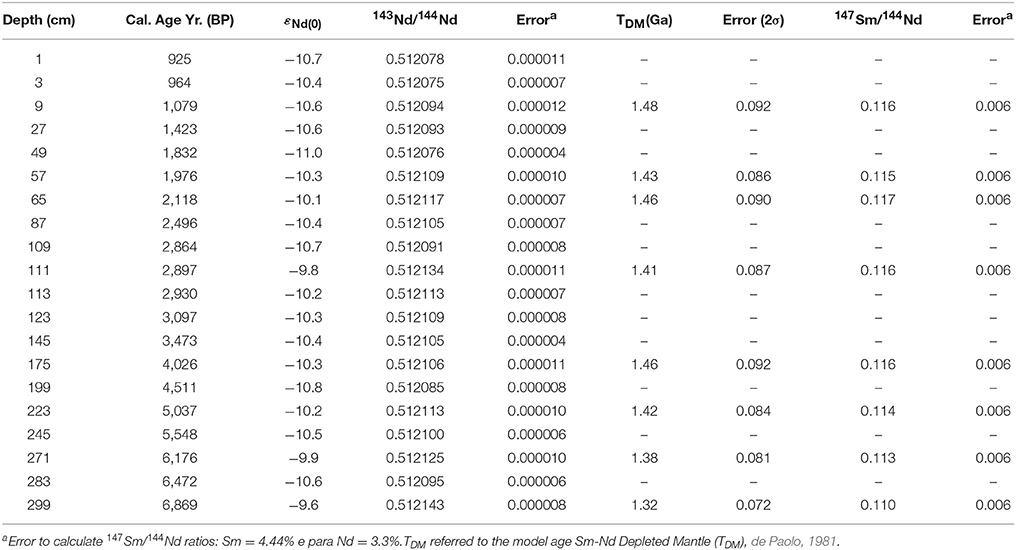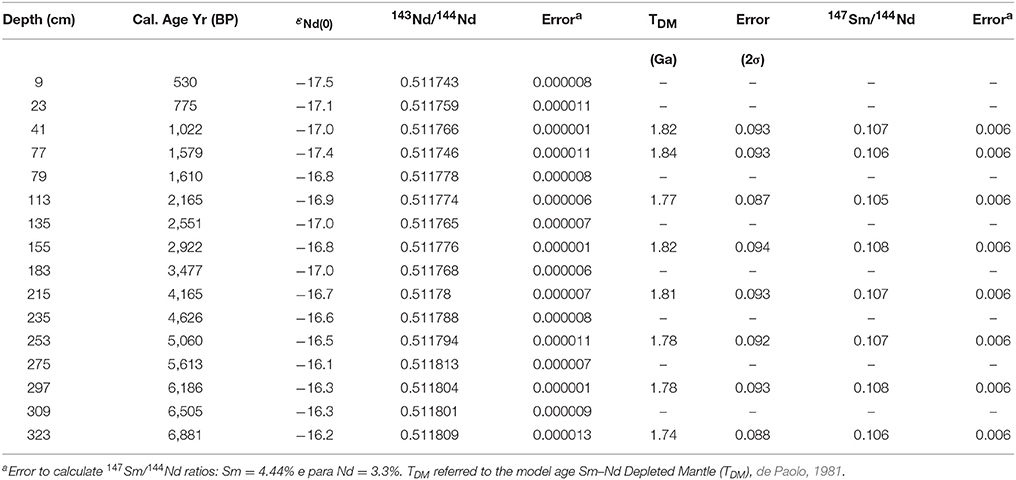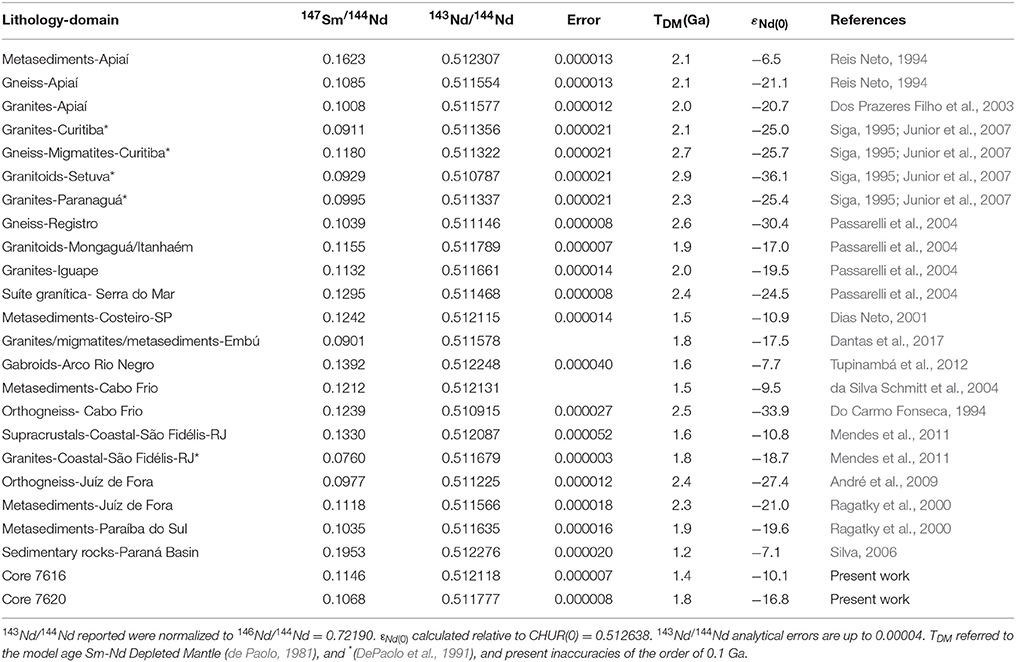- 1Departamento de Oceanografia Física, Química e Biológica (DOF), Oceanographic Institute of São Paulo University, São Paulo, Brazil
- 2Departamento de Mineralogia e Geotectônica (GMG), Institute of Geosciences of São Paulo University, São Paulo, Brazil
- 3Divisão Científica de Tecnologia de Petróleo, Gás Natural e Bioenergia, Institute of Energy and Environment of São Paulo University, São Paulo, Brazil
- 4Departamento de Geologia (DEGEO), Federal University of Rio de Janeiro, Rio de Janeiro, Brazil
Based on radiogenic isotope systems of neodymium [Epsilon Neodymium-εNd(0), 143Nd/144Nd, 147Sm/144Nd, and Sm-Nd Depleted Mantle Model ages-TDM] from current and previous data of continental rocks and associated sediments, this work provides the provenance of Holocene sediments from the Southwestern Atlantic Margin. The isotopic variability reported along the cores 7616 and 7620 are related to paleoceanographic and paleoclimatic changes. Further, we display the first Nd radiogenic isotope system distribution map of the study area. The map is the result of the principal component and clustering analyses of data compiled from the Ribeira belt, Luís Alves craton, and Paraná basin rocks. Differences in Nd isotopic signatures allowed the distinction between the sediment sources of the cores. The Core 7616 exhibits εNd(0) average value of −10.5, TDM = 1.4 Ga and 143Nd/144Nd = 0.512103, while the Core 7620 shows εNd(0) average value of −17.5, TDM = 1.8 Ga and 143Nd/144Nd = 0.51177. The relative more radiogenic Nd ratios from the Core 7616 are associated to the contribution of sediments from the Paraná basin, nevertheless less radiogenic values are observed along the Core 7616 between ~2,000 and 1,800 cal. yr BP. We have attributed the lower Nd ratios, recorded during this interval, to the decreasing influence from the Rio de la Plata estuary in the Core 7616. Remarkable less radiogenic Nd ratios are also recorded in the Core 7620 during the late Holocene. The intensification of the NE winds and the South America Summer Monsoon (SASM) enhanced the terrigenous input from the Paraíba do Sul River and southwards sediment transport by the Brazil Current (BC), providing higher contribution of less radiogenic metasediments from the Paraíba do Sul geotectonic domain to the Core 7620.
Introduction
An efficient way to reconstruct sediment provenance is the use of radiogenic isotope systems (e.g., Allégre et al., 1996; Wealdeab et al., 2002; Cruces et al., 2004; Fagel et al., 2014) because most of them are not affected by significant fractionation, when submitted by environmental processes (Dickin, 1995; Banner, 2004). Neodymium isotopes are recognized as excellent tracers of sediment origin, providing the characterization of the detrital material in relation to their sources rocks, through the establishment of radiogenic isotope systems [e.g., 143Nd/144Nd, εNd(0) values and Sm-Nd model ages] (e.g., O'nions et al., 1983; Nelson and Depaolo, 1988; Nascimento et al., 2003; Roig et al., 2005; de Mahiques et al., 2008; Bazhenova et al., 2017; Theiling et al., 2017).
Metasediments from the Ribeira belt have been considered as relevant sources of sediments to the SE Brazilian shelf (e.g., Suguio et al., 1972; Rocha et al., 1975; Gyllencreutz et al., 2010). Nevertheless, the influence of basalts from the Paraná basin [i.e., contribution of low TiO2 tholeiitic basalts from the Paraná Magmatic Province (PMP), Marques et al., 1999] on the S/SE Brazilian shelf has been reported since the seventies (e.g., Carraro et al., 1974; Miliman, 1975; Rocha et al., 1975), and related to the sediment transport by the Rio de La Plata plume (e.g., de Mahiques et al., 2008; Nagai et al., 2014).
In this study, rocks from the Paraná basin, and Precambrian terrains of the Ribeira belt and the Luís Alves craton (Figure 1) are evaluated as possible sources of the SW Atlantic margin. The strengthened of the SASM (Cruz et al., 2005) provides an efficient sediment transport from the hydrographic systems to the shelf. This terrigenous input has been associated with the relative high proportion of detrital material deposited in the estuary of Rio de la Plata (Chiessi et al., 2010).
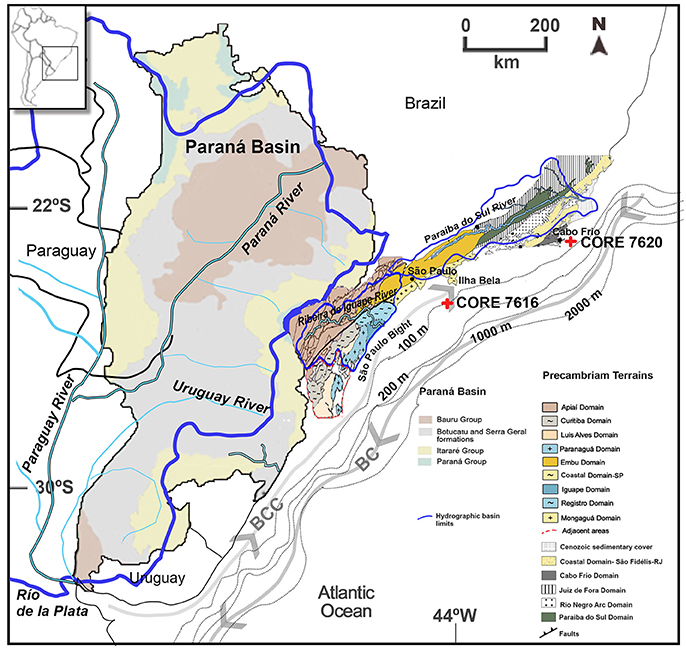
Figure 1. Regional geotectonic context of the area investigated as possible sources for cores 7620 and 7616 (red marks), showing Paraíba do Sul, Río de la Plata, and Ribeira de Iguape River basin limits (blue lines). Gray lines show major surface current directions in the study area: BC (Brazil Current) and BCC (Brazilian Coastal Current). Compiled from Siga (1995), Milani et al. (1996), Campanha and Sadowski (1999), Carlos Pedrosa-Soares et al. (1998), Marques et al. (1999), Milani and Thomaz Filho (2000), Dias Neto (2001), Heilbron et al. (2004), Passarelli et al. (2004), and Valladares et al. (2008).
During austral winter, the distribution of sediments along the South Atlantic coast is affected by the expansion of the Plata plume, which is transported northwards by the Brazilian Coastal Current (de Souza and Robinson, 2004) (Figure 1). These hydrodynamic configuration is enhanced with the intensification of the southerly winds (e.g., Möller et al., 2008), enabling the transport of material previously deposited in the Rio de La Plata estuary under the influence of the increased SASM. On the other hand, during the austral summer, the NE winds are associated to the southwards sediment transport along the east coast of South America by the BC flow (Figure 1).
We have characterized the Nd radiogenic isotope system of the sediments from cores 7616 and 7620, and compared with previously reported Nd isotopic data from the basement rocks of the Brazilian shield, sedimentary and volcanic rocks of the Paraná basin, and associated sediments in order to assess the source of sediments from the east coast of South America.
The deposition of sediments from the Rio de la Plata estuary in the Core 7616, and coarser sediments in the Core 7620 from the Rio Paraíba do Sul have been indicated by previous work (Gyllencreutz et al., 2010), based on the grain size analysis. The aim of the present study is to provide Nd isotopic signatures from the cores 7616 and 7620 in order to refine previous reported paleoceanographic interpretations, pointing out the paleoclimatic events and the associated hydrodynamic circulation patterns prevailing over the SW Atlantic margin during the late Holocene.
Study Area
Since river basins and oceanographic setting play a crucial role in the distribution and transport of sediments on the SW Atlantic Margin, our first attempt at understanding the sediment provenance of the cores 7616 and 7620 was to determine the geotectonic domains drained by river systems that could contribute with sediment load to the shelf, and investigate the paleoceanographic circulation off the continental area. We have considered Paraíba do Sul (PS), Paraná-la Plata (PP), and Ribeira de Iguape (RI) as river systems with potential weathering flux, draining rocks from the Paraná basin and the Ribeira belt, which is inserted in the Precambrian terrains (Figure 1).
Continental Setting
Geology, Hydrography, and Morphology
The geological setting of the Ribeira belt is divided in 13 geotectonic domains: Embú, Paraíba do Sul, Juíz de Fora, Rio Negro Magmatic Arc, Cabo Frio, Apiaí, Curitiba, Paranaguá, Iguape, Registro, Mongaguá-Itanhaém, and Coastal, which includes metasediments of the Coastal domains of São Paulo and São Fidélis (Figure 1) (Siga, 1995; Campanha and Sadowski, 1999; Heilbron et al., 2004; Valladares et al., 2008; Bento dos Santos et al., 2011; Dias Neto, 2001; Passarelli et al., 2004). The Paraná basin, located in the SW portion of the South America (Figure 1), is characterized as an intracratonic basin constituted by sedimentary sequences (e.g., Milani et al., 1996) and volcanic rocks from the PMP (Marques et al., 1999). Some geotectonic domains occur near the coastline and therefore are considered here as potential sources of sediments (e.g., medium to high grade metamorphic terrains from the Luiz Alves craton, Registro, Iguape, Mongaguá-Itanhaém, and Coastal domains).
The sedimentary rocks of the Paraná basin are the result of erosion of the Serra do Mar that is a 1.500 km ridge, which has provided eroded material from the Upper Continental Crust (UCC) to the continental basin (e.g., the Bauru Group from the Paraná basin) since the late Cretaceous (Almeida and Carneiro, 1998). Gallagher et al. (1994) suggested that the sedimentation related to the uplift of the Serra do Mar ridge has also provided thick debris from the Ribeira belt, as well as a high proportion of material from coastal basalts of the Serra Geral formation to the ocean and to the continental basin. Holocene tectonism is active in the area (e.g., the Taubaté tectonic basin, Riccomini et al., 2004) and may have been still providing detrital material from the basement to the studied area. Thus, we can consider that large proportion of sediments eroded from the Paraná basin is a mixture between mantle rocks (e.g., the basalts from the Serra Geral formation) and the UCC rocks (e.g., metasediments from the Ribeira belt).
To the north of Iha Bela (24°30′S) (Figure 1), the basement rocks of the Ribeira belt deep close to the coastline, compared to the sector to the south of the Island, where a greater distance from the ridge to the ocean is observed. The hydrographic network of the PS is the largest drainage basin that flows into the ocean to the north of the Core 7620 (Figure 1). It has an outflow of ~1.118 m3/s.
The PP hydrographic systems, including the Paraná, Uruguay and La Plata rivers (Figure 1), convey material eroded from the basalts (e.g., the Serra Geral formation) and sedimentary rocks of the Paraná basin adding sediment load to the Rio de La Plata estuary (Pasquini and Depetris, 2007). PP hydrographic system is the second largest drainage basin area in the South America, with an outflow of around 23.000 m3/s and 57 million m3/year of sediment delivered into the South the Atlantic ocean. This system accounts for about 80% of its total discharge to the SW Atlantic Ocean (Pasquini and Depetris, 2007) and contributes with almost 60% water discharge to the Rio de La Plata (López Laborde, 1997).
The main morphological feature of the RI is the Ribeira valley. It has developed inside the Serra do Mar ridge facing to the sea where metasediments of the Ribeira belt have been subjected to intense erosion since the late Cretaceous (Gallagher et al., 1994; Almeida and Carneiro, 1998; Castanheira, 2006). The RI river system constitutes the largest group of rivers flowing directly to the ocean off the São Paulo state (Figure 1), and it may influence the sedimentation of the Core 7616.
Oceanographic and Climatic Setting
The studied cores are located in a sector of the SW Atlantic margin called the São Paulo Bight (Zembruski, 1979) (Figure 1). The geomorphological differentiation is one of the factors that conditioned the sediment distribution over the shelf. The sedimentation over the São Paulo bight presents a marked differentiation to the north and south of Ilha Bela. This Island has been considered as a mark that distinguishes sedimentary patterns prevailing on the inner shelf off SE Brazil (Rocha et al., 1975; Kowsmann and Costa, 1979; de Mahiques et al., 1999, 2004). According to de Mahiques et al. (1999), to the south of the Island, the deposition of muddy sediments and terrigenous organic matter are observed oceanward. To the north of Ilha Bela, larger amounts of fine sediments and organic matter are deposited on the inner shelf.
The water masses dynamics prevailing on the SW Atlantic margin have been strongly influenced by the wind regime (e.g., de Mahiques et al., 2002). The southwards migration of the Intertropical Convergence Zone (ITCZ) (e.g., Haug et al., 2001), the configuration of the South Atlantic anticyclone (SAA), the intensification on the NE wind system (Figure 2A), as well as the strengthening of the SASM have influenced continental and oceanic processes over the South America and the South Atlantic Ocean, during the late Holocene. The SAA, a system of high pressure center located around the latitude of 30°S in the South Atlantic Ocean, differently influences the climate of Brazil. During the austral summer, the SAA displaces slightly southeastwards assuming a more oriented anticyclonic circulation shape (e.g., Bastos and Ferreira, 2008). This configuration enhances the moisture on the coast off Cabo Frio and throughout the southeast Brazilian coast, whereas the SASM, facilitated by the NE trade winds (Figure 2A), provides higher moisture penetration in the Amazon basin. These main climate systems can indirectly affect the availability of sediments in river mouths and their distribution on continental shelves. During the austral summer, the strengthening of the NE winds and configuration of the SAA may facilitate the southward sediment transport by the BC. The BC is part of the South Atlantic subtropical meander, integrating a western boundary current system that takes at least 3 km from the water column. On the inner shelf, the action of the BC water masses, the Tropical Water (TW) and the South Atlantic Central Water (SACW) (Figure 2B), play the major role over the sedimentation (de Castro Filho et al., 1987). The displacement of the less dense Costal Water (CW), during the rainy seasons, transports terrigenous sediments and organic matter to the south of Ilha Bela toward the deeper parts of the shelf (de Mahiques et al., 1999, 2004). The cold and dense SACW moves toward the coast during the austral summer, generating a seasonal upwelling (de Mahiques et al., 1999). According to de Mahiques et al. (2005), the increase of the upwelling process off Cabo Frio is related to the intensification of the BC. On the other hand, the BCC flows to the north of the east coast of South America (Figure 1). The BCC transports sediments from the Rio de La Plata estuary to lower latitudes. This transport is facilitated during the austral winter, when the Rio de La Plata plume expansion occurs, and the SW winds are prevailing (e.g., Piola et al., 2000; Möller et al., 2008).
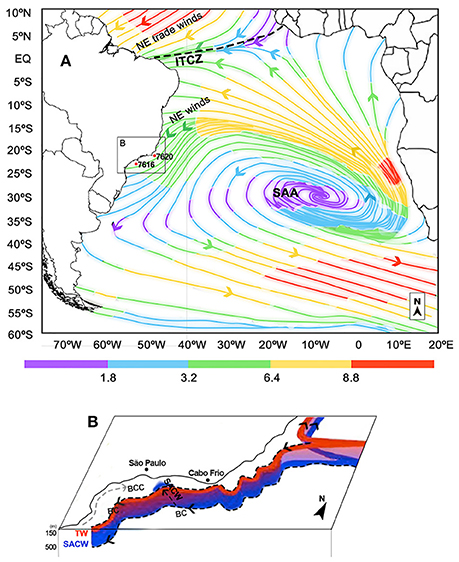
Figure 2. (A) Wind field average in 1,000 hPa, for summer months (DJF) obtaining from daily National Centers for Environmental Prediction (NCEP) data during a period from 1978 to 1997: colored lines representing wind current speed (m/s), modified after Bastos and Ferreira (2008). (B) Zoom of currents and water masses prevailing in the study area, showing the displacement of the South Atlantic Coastal Water (SACW) and the Tropical Water (TW) transport by Brazil Current (BC); water masses are simplified from Calado (2006).
Materials and Methods
Cores 7616 and 7620 were collected on the SE Brazilian shelf, on board the R.V. Prof. W. Besnard, in 2005. The Core 7620 was retrieved in the shelf off Cabo Frio at 22°94′S and 41°98′W, and water depth of 44 m. The Core 7616 was collected off Santos city, in the São Paulo state, at the latitude 25°5.88′S and longitude 45°38.64′W, and water depth of 100 m. The coring locations are shown in Figure 1.
The sediment samples were analyzed for Nd radiogenic isotopes. We avoid the use of strong acids in the Sm-Nd isotope system since the use of HCl (1N) (Revel et al., 1996) induces significant REE removal (Clauer et al., 1993), and dramatically alters 147Sm /144Nd and 143Nd /144Nd ratios (Innocent et al., 2000). Different procedures of acid attacks, detailed in Mantovanelli (2013), were tested to determine the optimal leaching sequence for our sediments. Thus, the samples passed through a partial extraction to remove bioclasts. According to our results on Nd isotopes, we followed the procedures described in Bayon et al. (2002). We used HOAc (10% vv) to attack 500 mg of each previously powdered bulk sediment samples, which remained in an ultrasonic bath for 4 h. The samples were dissolved with HF-HNO3, and then passed through ion exchange columns (RE) and (Ln) to separate REE and Nd respectively, according to the Geochronological Research Center of São Paulo University (CPGeo- IGc-USP) analytical protocol. Nd isotopic analyses were conducted with a FINNIGAN MAT 262 mass spectrometer. Nd ratios were normalized to a 146Nd/144Nd = 0.7219 (de Paolo, 1981). The parameter εNd(0) corresponds to the current value (t = 0) and is calculated according to the equation: = {[(143Nd/144Nd)] m /0.512638] −1} * 104, where 143Nd/144Nd chondritc uniform reservoir (CHUR) = 0.512638 (Hamilton et al., 1983). The JNdi standard from January to July 2012 was run for the 143Nd/144Nd ratio with each batch of samples, resulting in the mean value of 0.512099 ± 0.000008. The analytical blanks during the analyses were about 0.03 ng.
The Rare Earth Elements (REE) concentrations were calculated by ICP-MS, and other trace elements by ICP-OES, for each sample in the Chemistry Laboratory of IGc-USP.
REE patterns for selected samples from the cores (values normalized according to Taylor and McLennan, 1995) (Supplementary Figures 1–3). The concentration of Samarium (Supplementary Table 1) was used to obtain 147Sm/143Nd ratios in order to calculate the model ages (TDM) of the cores. The details of the analytical procedure used for ICP-MS are in Navarro et al. (2008) and ICP-OES are available in Janasi et al. (1997). The determination of the concentration of chemical elements was performed by mass spectrometry inductively-coupled plasma ICP-MS equipped with a quadrupole spectrometer, Perkin Elmer/Sciex model ELAN 6100DRC and spectometer with minitorch model ARL 3410ICP.
We performed a cluster analysis using the εNd(0), 147Sm /144Nd, 143Nd /144Nd, and TDM as parameters of sediment provenance, after obtaining the Principal Component Analysis (PCA) using the Past v.2.17 software (Hammer et al., 2001). The data fit the condition for a suitable PCA, showing normal distribution and correlation between Nd parameters with r2 > 0.96. The cluster analysis of the samples was based on a quantitative similarity index (Euclidean). A neighbor joining clustering was performed with the scores resulted from the PCA of the normalized parameters. The first component (PC1) explains 77.7% of the total variance.
In order to characterize the provenance of the sediments from the cores, we present the first summarized data of Nd radiogenic isotope system from multiple sources: Do Carmo Fonseca (1994), Reis Neto (1994), Siga (1995), Campanha and Sadowski (1999), André et al. (2009), Ragatky et al. (2000), Tupinambá et al. (2012), Dias Neto (2001), Dos Prazeres Filho et al. (2003), Heilbron et al. (2004), Passarelli et al. (2004), Silva (2006), Junior et al. (2007), Valladares et al. (2008), Bento dos Santos et al. (2011), Mendes et al. (2011), and Dantas et al. (2017), as well as a Nd distribution map for the study area. The compilation has included isotopic data from marine and river sediments related to the evaluated continental rocks: (A) εNd(0) data of superficial sediments from the Rio de La Plata estuary and Argentinian shelf (Basile et al., 1997; de Mahiques et al., 2008); (B) Nd data associated with eroded rocks of Coastal Domain of the Ribeira belt; (C) Nd radiogenic isotope signatures of Paraíba do Sul River suspended load (Roig et al., 2005). The data of the compilation is available in the Supplementary Table 2 and in Mantovanelli (2013). The details of the model age from the cores 7616 and 7620, based on 14C dating, are available in de Mahiques et al. (2011).
Results and Discussion
Neodymium
The 147Nd/143Nd ratios of the Core 7616 vary between 0.51207 and 0.51214 with an average of 0.51210, εNd(0) values range from −11.0 to −9.6; the 147Sm/144Nd ratios are varying from 0.110 to 0.117 and the Sm-Nd model ages (TDM) are around 1.4 Ga (Table 1). The 147Nd/143Nd ratios of the Core 7620 vary between 0.51174 and 0.51181 with an average of 0.51180; the values of 147Sm/144Nd range from 0.105 to 0.108; εNd(0) values vary from −17.5 to −16.1, exhibiting a significant decrease compared to the Core 7616 (Table 2).
In relation to the Core 7616, a relevant increase of 0.4 Ga in Sm-Nd model ages (TDM) is observed in the Core 7620. Lower εNd(0) values and older Sm-Nd model ages (TDM) show a particular contribution of UCC components in the Core 7620.
The diagram of εNd(0) values and TDM displays a comparison among samples of the Core 7616, rocks from the southernmost part of the Ribeira belt, the Luís Alves craton and sedimentary rocks of the Paraná basin (Figure 3). The diagram shows that sedimentary rocks of the Paraná basin, metasediments from the Coastal Domain and the Core 7616 present similar Nd radiogenic values. The granitoids present an intermediate aspect, while the metamorphic rocks of the adjacent Luís Alves craton, and the Apiaí Domain from the Ribeira belt exhibit a distinct behavior (Figure 3). On the other hand, Nd isotopic signatures of sediments from the PS river and the Core 7620 show similar composition values (Figure 4), pointing out the metasediments from the Paraíba do Sul and correlated Embú domains [εNd(0) average of about −16 and TDM ~1.7 Ga, Ragatky et al., 2000] as potential source rocks of the Core 7620 [εNd(0) average of about −17 and TDM ~1.8].
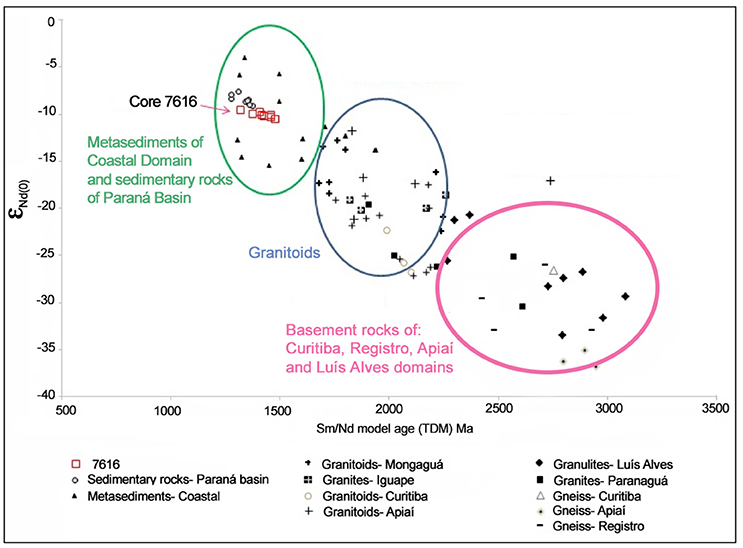
Figure 3. Diagram showing εNd(0) values vs. Sm/Nd model ages (TDM) of the Core 7616 and investigated source rocks (Ma).
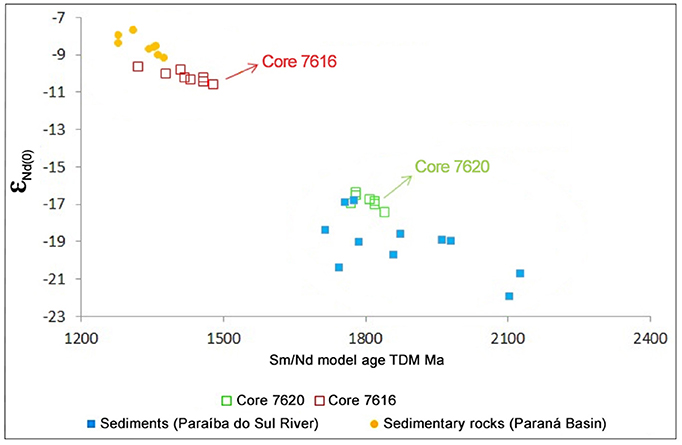
Figure 4. Diagram of εNd(0) vs. Sm/Nd model age (TDM) (Ma): showing the comparison between isotopic signatures of the Core 7616 and sedimentary rocks from the Paraná basin, and the Core 7620 and sediments from the Paraíba do Sul River.
Multivariate Analysis: Nd Systematic
The results obtained so far are further analyzed with the aid of principal components and cluster analyses based on the values from the compilation of Nd isotopic signatures of Precambrian metamorphic terrains of the Ribeira belt, Luís Alves craton, sedimentary rocks of the Paraná basin and sediments from the cores 7616 and 7620 (Figure 1 and Supplementary Table 2). For simplicity of comparison, we calculated the average for all samples from each lithology of the distinct domains (Table 3). The dendogram distinguishes three principal groups with similar isotopic characteristics (Figure 5).
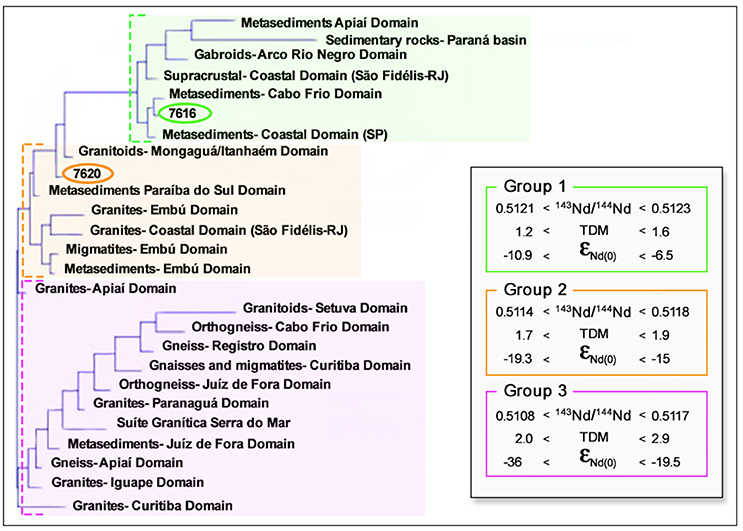
Figure 5. Dendogram elaborated from cluster after PCA analyses on Nd isotopic data, showing three major groups: Group 1 with 143Nd/144Nd from 0.5121 to 0.5123, TDM from 1.2 to 1.6 and εNd(0) from −10.9 to −6.5; Group 2 with 143Nd/144Nd from 0.5114 to 0.5118, TDM from 1.7 to 1.9 and εNd(0) from −19.3 to −15; Group 3 with 143Nd/144Nd from 0.5108 to 0.5117, TDM from 2.0 to 2.9 and εNd(0) from −36 to −19.5.
The Core 7616 are in Group 1 (Figure 5), corroborating the Nd systematic diagram previously explained (Figure 3), where the isotopic signatures from the Core 7616, metasediments of the Coastal domains and sedimentary rocks of the Paraná basin are relatively similar. The range of εNd(0) values of Group 1 (from −10.9 to −6.0) prevents the distinction between sedimentary rocks from the Paraná basin and the rocks from the Coastal Domain. Rocks and sediments with mantle components have higher εNd(0) than −10.9, and therefore we added the Subgroup 1A with εNd(0) values ranging from −7.7 to −6.0.
Metasediments of the Ribeira belt from the Apiaí Domain have very old TDM ages (2.1 Ga) to be considered source of the Core 7616, although they are in Group 1 (Figure 5), probably because of the low εNd(0) parameter (−6.5), which has relevant importance on the PCA. The mantle components from the Rio Negro Domain allowed its isotopic signatures to be in Group 1. However, this domain is situated out of the fluvial system and coastline areas that could affect the sedimentation in the Core 7616.
The Core 7620 is in Group 2 (Figure 5), pointing out the friable metasediments of the Paraíba do Sul and correlated Embú domains as its main source, as indicated from the Nd diagram previously showed (Figure 4). It is unlikely that granites and granitoids from Group 2 have contributed to large amounts of sediments to the shelf due to their resistance under weathering conditions, as reported by Castanheira (2006).
It is very worthwhile to observe that the Cabo Frio orthogneiss and the Setuva granitoids although they are located in different places (Figure 1) they are in Group 3 probably because they belong to old basement rocks. On the other hand, metasediments from Cabo Frio are in Group 1 together with metasediments from Coastal domains in the São Paulo state (Figure 1).
Finally, based on multivariate analysis, we present the neodymium isotope distribution map of the investigated source rocks (Figure 6).
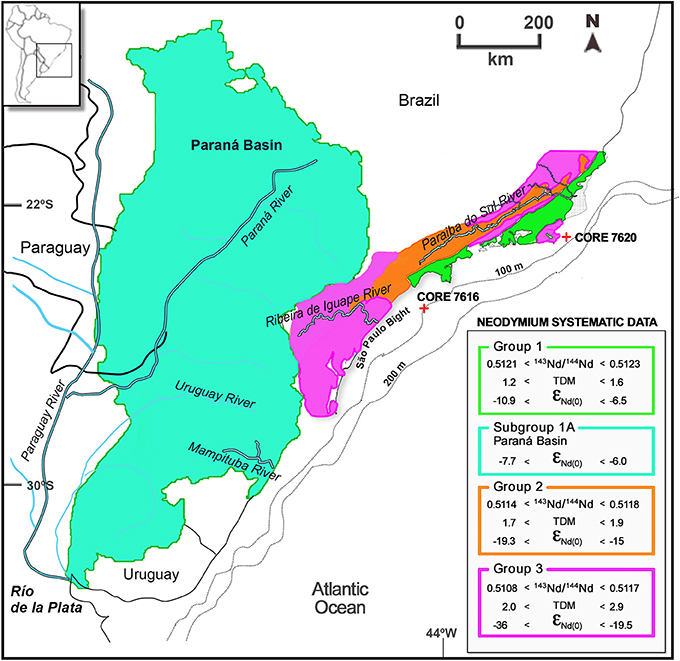
Figure 6. Neodymium isotope distribution map of the investigated source rocks based on PCA and Cluster analyses results. Group 1: represented by the green (Coastal domains from the Ribeira belt and bluish green subgroup 1A (sedimentary rocks of the Paraná basin); Group 2: represented by the orange (Paraíba do Sul and Embú domains from the Ribeira belt); Group 3: represented by the pink (Rocks from older pre-Cambrian domains of the Ribeira belt and the Luís Alves craton).
How Are the Mantle Components Incorporated in Sediments From the SE Brazilian Shelf?
The Nd isotopic signatures of sedimentary rocks of the Paraná basin and the Rio de La Plata sediments coincide with those of the Core 7616 (Figures 4, 7, respectively) The question is whether the mantle component present in the Core 7616 is from local or distal source contribution.
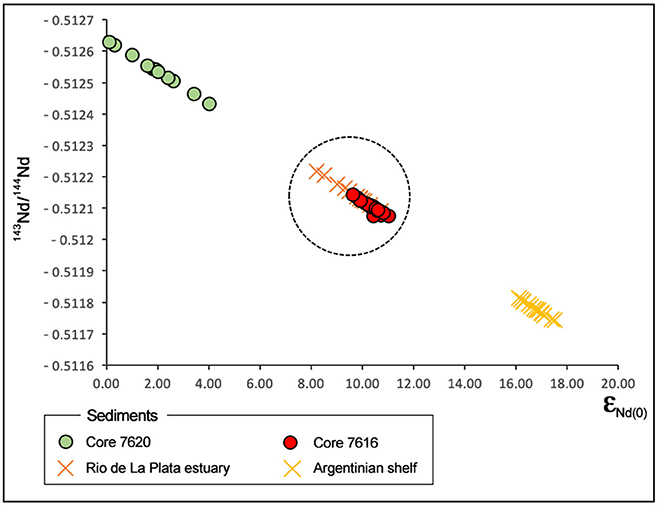
Figure 7. Diagram of εNd(0) values vs. 143Nd/144Nd showing the similarities between the Core 7616 and sediments from the Rio de La Plata estuary.
Since Nd isotopic variation is registered along the Core 7616, we have considered an influence of alternating higher/lower contribution of sediments with less radiogenic Nd ratios from the local Coastal Domain, and more radiogenic Nd ratios from the distal Rio de La Plata estuary. The influence of the Rio de La Plata sediments on the Core 7616 is restricted to the northwards transport of clay by the expansion of the La Plata plume and the action of the BCC, on the intervals with relative higher εNd(0) values.
River Input and Oceanic Circulation
Intensification of the SASM recorded by oxygen isotope of speleothems (Cruz et al., 2005) and associated increase on chemical weathering over the SE South America provided higher sediment input into the Rio de La Plata (Chiessi et al., 2010) during the late Holocene. The variability in precipitation have influenced the studied sites in different ways. Besides the cores be relatively close together (~400 km), we must emphasize that the cores 7616 and 7620 are located to the south and the north of Ilha Bela, respectively, therefore in areas under distinct geomorphological and sedimentological configurations and, distinct hydrodynamic systems.
Isotopic variations along the Core 7616 are here associated with changes in provenance, reflecting the action of different mechanisms that govern the paleoenvironmental processes. We interpret that the remarkable isotopic signal of the UCC [relative lower εNd(0) values and older TDM ages of −11 and 1.65 Ga, respectively] registered in the Core 7616 between 2000 and 1800 cal. yr BP (Figure 8) is related to the intensification of the SASM, which probably favored the chemical weathering over the local domains increasing terrigenous sediment input to the shelf. According to previous work during the austral summer, the CW transports fine sediments toward the outer shelf since muddy sediment deposits are observed to the south of Ilha Bela. This clay could be transported back to the inner shelf by the action of the SACW during episodes of strong intensification of NE winds and resurgence process over the São Paulo bight. Thus, our results evidence an enhanced action of the SACW in the Core 7616 and, consequent, decreasing influence of the La Plata estuary sediments, transported northwards by the BCC, from 1,800 to 2000 cal. yr BP.
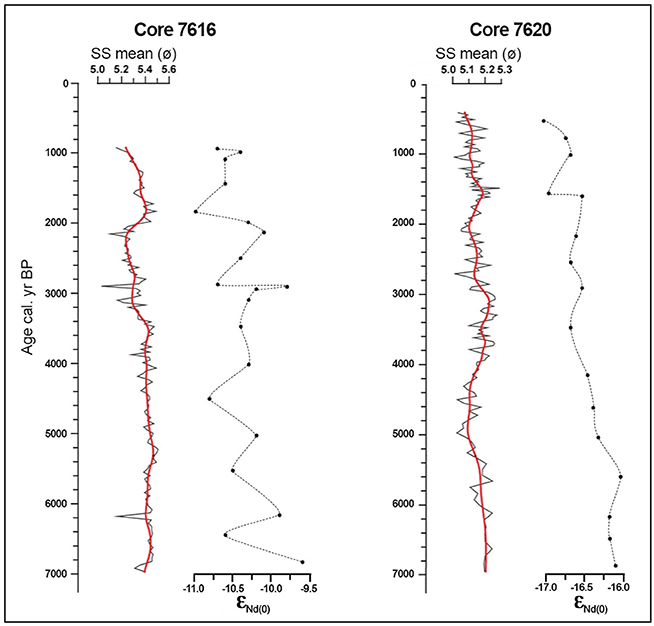
Figure 8. Comparison between the sortable silt (SS) mean reported by Gyllencreutz et al. (2010) and the εNd(0) data from the present work for the cores 7616 and 7620. The red line represents the smoothed curve; the black dots are the variation of εNd(0) data from the present work.
Our isotopic data indicates that the register of continental input from the Paraíba do Sul River associated with the southwards sediment transport by the BC superimposed the intensification of the resurgence processes off Cabo Frio on the inner shelf, during the late Holocene. This hypothesis is consistent with the high proportion of coarser sediments transported from the Paraíba do Sul River to the inner shelf off Cabo Frio reported by Gyllencreutz et al. (2010), and with the increasing trend of relative lower εNd(0) values, registered in this work, toward to the top of the Core 7620 (Figure 8).
Conclusions
The use of Nd radiogenic isotopes proved to be very promissory in identifying sources areas of marine sediments. Our compilation of Nd radiogenic data from the Ribeira belt, rocks of the Paraná basin and the Luís Alves craton resulted in a Nd systematic distribution map.
The comparison of the Nd radiogenic isotopes between the cores indicated distinct source rocks. Both are under influence of the metasediments from the Ribeira belt. However, the more radiogenic Nd ratios and higher εNd(0) values from the Core 7616 are attributed to the contribution from sources with mantle composition (e.g., basalts from the Serra Geral formation), corroborating the similar isotopic signatures from the sedimentary rocks of the Paraná basin, sediments from the Rio de La Plata estuary and the Core 7616.
The influence of UCC components in the Core 7616 can be explained by the contribution from local crustal sources related to the history of the uplift of the Serra do Mar ridge, which have provided detrital material from the Ribeira belt since the late Cretaceous and, up to the recent, through neotectonics. On the other hand, the mantle component may have its origin related to the younger distal source, by the northward transport of the fine size fraction of sediments from the Rio de La Plata, facilitated by the SW wind dynamics, as well as through the contribution from the erosion of coastal basalts.
The isotopic variation along the Core 7616 permitted to bring new interpretations about the sedimentation on the SW Atlantic margin. A relevant continental crust isotopic signature is registered in the Core 7616 from 2000 to 1800 cal. yr BP, probably resulted from the enhanced NE winds and, consequent, intensification of the SACW transporting the muddy sediment, previously taken to the outer shelf by the CW, back to the inner shelf, indicating decreasing influence of sediments from the Rio de La Plata estuary during the late Holocene.
Observing the average values of the Nd data and the results from the Principal component and clustering analyses, we have concluded that the Core 7620 is under the influence of the sediment input from PS River, particularly from the metasediments of the Paraíba do Sul Domain inserted in the Ribeira belt.
The southward migration of the ITCZ, the intensification of the SASM, and concomitant strengthen of the BC sediment transport to the south left their record in the Core 7620 through episodes of enhanced fluvial transport (i.e. the great input of sediments from the Paraíba do Sul River) registered by the relatively lower εNd(0) values and less Nd radiogenic ratios during the late Holocene.
Author Contributions
SM analyses, discussion of data, and writing of the manuscript. CT analyses and discussion of data. MM collection and discussion of data. LJ discussion of data and writing of the manuscript. EB discussion of data.
Conflict of Interest Statement
The authors declare that the research was conducted in the absence of any commercial or financial relationships that could be construed as a potential conflict of interest.
Acknowledgments
The authors wish to thank the Institute of Oceanography of the University of São Paulo, for providing samples. Thanks are also to the technicians of the Geochronological Research Center of the University of São Paulo, for the Nd isotopic analyses. Financial support was provided by the Conselho Nacional de Desenvolvimento Científico e Tecnológico (CNPq), via grant 552080/2008-0 and the Coordenação de Aperfeiçoamento de Pessoal de Nível Superior (CAPES), via grant 38/2014—IODP/CAPES-Brazil. The publication fee was financed by Fundação de Amparo à Pesquisa do Estado de São Paulo (FAPESP) via grant 2018/10557-6.
Supplementary Material
The Supplementary Material for this article can be found online at: https://www.frontiersin.org/articles/10.3389/feart.2018.00074/full#supplementary-material
References
Allégre, C. J., Dupré, B., Gaillarde, J., and Négrel, P. (1996). Sr-Nd-Pb isotopes systematics in Amazon and Congo rivers systems, constraints about erosion processes. Chem. Geol. 131, 93–112. doi: 10.1016/0009-2541(96)00028-9
Almeida, F. F. M., and Carneiro, C. D. R. (1998). Origem e evolução da serra do mar. Rev. Bras. Geociências 28, 135–150.
André, J. L. F., Valladares, C. S., and Duarte, B. P. (2009). O complexo juiz de fora na região de três rios (rj): litogeoquímica, geocronologia U-Pb (LA-ICPMS) e geoquímica isotópica de Nd e Sr. Rev. Brasil. Geociências 39, 773–793.
Banner, J. L. (2004). Radiogenic isotopes: systematics and applications to earth surface process and chemical stratigraphy. Earth Sci. Rev. 65, 141–194. doi: 10.1016/S0012-8252(03)00086-2
Basile, I., Grousset, F. E., Revel, M., Petit, J. R., Biscaye, P. E., and Barkov, N. I. (1997). Patagonian origin of glacial dust deposited in East Antarctica (Vostok and Dome C), during glacial stages 2, 4 and 6. Earth Planet. Sci. Lett. 146, 573–589. doi: 10.1016/S0012-821X(96)00255-5
Bastos, C. C., and Ferreira, N. J. (2008). “Análise climatológica da alta subtropical do Atlântico Sul,”in Congresso Brasileiro de Meteorologia, 15, São Paulo. Anais (São Paulo: SBMET), 12–619.
Bayon, G., German, C. R., Boella, R. M., Milton, J. A., Taylor, R. N., and Nesbitt, R. W. (2002). An improved method for extracting marine sediment fractions and its implication to Sr and Nd isotopic analisys. Chem. Geol. 187, 179–199. doi: 10.1016/S0009-2541(01)00416-8
Bazhenova, E., Fagel, N., and Stein, R. (2017). North American origin of “pink–white” layers at the Mendeleev Ridge (Arctic Ocean): new insights from lead and neodymium isotope composition of detrital sediment component. Mar. Geol. 386, 44–55. doi: 10.1016/j.margeo.2017.01.010
Bento dos Santos, T. M., Munhá, J. M., Tassinari, C. C. G., and Fonseca, P. E. (2011). The link between partial melting, granitization and granulite development in central Ribeira Fold Belt, SE Brazil: new evidence from elemental and Sr e Nd isotopic geochemistry. J. South Am. Earth Sci. 31, 262–278. doi: 10.1016/j.jsames.2011.01.004
Calado, L. (2006). Dinâmica da interação da atividade de meso-escala da Corrente do Brasil com o fenômeno da ressurgência costeira ao largo de Cabo Frio e Cabo de São Tomé, RJ. thesis, Instituto Oceanográfico, Universidade de São Paulo.
Campanha, G. A. C., and Sadowski, G. R. (1999). Tectonics of the southern portion of the Ribeira Belt (Apiai Domain). Precambrian Res. 98, 31–51. doi: 10.1016/S0301-9268(99)00027-3
Carlos Pedrosa-Soares, A., Vidal, P., Leonardos, O. H., and de Brito Neves, B. B. (1998). Neoproterozoic oceanic remnants in eastern Brazil: further evidence and refutation of an exclusively ensialic evolution for the Araçuaí-West Congo orogen. Geology 26, 519–522. doi: 10.1130/0091-7613(1998)026<0519:NORIEB>2.3.CO;2
Carraro, C. C., Gamermann, N., Eick, N. C., Bortuluzzi, C. A., Jost, H., and Pinto, J. F. (1974). Mapa Geológico do Estado do Rio Grande do Sul. (Mapa n. 8), Instituto de Geociências, UFRGS, Porto Alegre.
Castanheira, M. V. S. (2006). “Evolução da rede de drenagem controlada por nível de base regional e evidências do processo de captura fluvial, no médio vale do Rio Paraíba do Sul,” in SIMPÓSIO NACIONAL DE GEOMORFOLOGIA, REGIONAL CONFERENCE ON GEOMORPHOLOGY (Goiânia: UFG), 1–10.
Chiessi, C. M., Mulitza, S., Pätzold, J., and Wefer, G. (2010). “How different proxies record precipitation variability over southeastern South America,” in IOP Conference Series: Earth and Environmental Science, Vol. 9 (IOP Publishing).
Clauer, N., Chaudhuri, S., Kralik, M., and Bonnot-Courtois, C. (1993). Effects of experimental leaching on Rb-Sr and K-Ar isotopic systems and REE contents of diagenetic illite. Chem. Geol. 103, 1–16.
Cruces, A., Freitas, M. C., Andrade, C., Munhá, J., Tassinari, C., Vale, C., et al. (2004). The importance of geochemistry in multidisciplinary studies of lagoonal environments at different time scales: the case of Santo André lagoon (SW Portugal). J. Coast. Res. 39, 1716–1722.
Cruz, F. W., Burns, S. J., Karmann, I, Sharp, W. D, Vuille, M., Cardoso, A. O, et al. (2005). Insolation-driven changes in atmospheric circulation over the past 116,000 years in subtropical Brazil. Nature 434, 63–66. doi: 10.1038/nature03365
Dantas, E. L., Hackspacher, P. C., Fetter, A. H., Sato, K., Pimentel, M. M., and Godoy, A. M. (2017). Nd isotope systematics related to Proterozoic evolution of the central Ribeira Belt in the State of São Paulo, SE Brazil. Rev. Bras. Geociências 30, 140–143.
da Silva Schmitt, R., Trouw, R. A., Van Schmus, W. R., and Pimentel, M. M. (2004). Late amalgamation in the central part of West Gondwana: new geochronological data and the characterization of a Cambrian collisional orogeny in the Ribeira Belt (SE Brazil). Precamb. Res. 133, 29–61. doi: 10.1016/j.precamres.2004.03.010
de Castro Filho, B. M., de Miranda, L. B., and Miyao, S. Y. (1987). Condições hidrográficas na plataforma continental ao largo de Ubatuba: variações sazonais e em média escala. Boletim do Instituto Oceanográfico 35, 135–151. doi: 10.1590/S0373-55241987000200004
de Mahiques, M. M., Bicego, M. C., Silveira, I. C., Susa, S. H., Lourenço, R. A., and Fukumoto, M. M. (2005). Modern sedimentation in the Cabo Frio upwelling system, Southeastern Brazilian shelf. Ana. Acad. Bras. Cienc. 77, 535–548. doi: 10.1590/S0001-37652005000300013
de Mahiques, M. M., da Silveira, I. C. A., e Sousa, S. H. D. M., and Rodrigues, M. (2002). Post-LGM sedimentation on the outer shelf-upper slope of the northernmost part of the São Paulo Bight, southeastern Brazil. Mar. Geol. 181, 387–400. doi: 10.1016/S0025-3227(01)00225-0
de Mahiques, M. M., Mishima, Y., and Rodrigues, M. (1999). Characteristics of the sedimentary organic matter on the inner and middle continental shelf between Guanabara Bay and São Francisco do Sul, southeastern Brazilian margin. Cont. Shelf Res. 19, 775–798.
de Mahiques, M. M., Sousa, S. H., Burone, L., Nagai, R. H., Silveira, I. C., Figueira, R. C., et al. (2011). Radiocarbon geochronology of the sediments of the São Paulo Bight (southern Brazilian upper margin). Ana. Acad. Bras. Cienc. 83, 817–834. doi: 10.1590/S0001-37652011005000028
de Mahiques, M. M., Tassinari, C. C. G., Marcolini, S., Violante, R. A., Figueira, R. C. L., Silveira, I. C. A., et al. (2008). Nd and Pb isotope signatures on the Southeastern South American upper margin: implications for sediment transport and source rocks. Mar. Geol. 350, 51–63. doi: 10.1016/j.margeo.2007.11.007
de Mahiques, M. M., Tessler, M. G., Ciotti, A. M., Silveira, I. C. A., Figueira, S. R. C. L., Tassinari, C. C. G., et al. (2004). Hydrodynamically driven patterns of recent sedimentation in the shelf and upper slope off Southeast Brazil. Cont. Shelf Res. 24, 1685–1697. doi: 10.1016/j.csr.2004.05.013
de Paolo, D. J. (1981). A neodymium and strontium isotopic study of the Mesozoic calc-alkaline granitic batholiths of the Sierra Nevada and Peninsular Ranges, California. J. Geophys. Res. Solid Earth 86, 10470–10488. doi: 10.1029/JB086iB11p10470
de Souza, R. B., and Robinson, I. S. (2004). Lagrangian and satellite observations of the Brazilian Coastal Current. Cont. Shelf Res 24, 241–262. doi: 10.1016/j.csr.2003.10.001
DePaolo, D. J., Linn, A. M., and Schubert, G. (1991). The continental crustal age distribution: Methods of determining mantle separation ages from Sm-Nd isotopic data and application to the southwestern United States. J. Geophys. Res. Solid Earth 96, 2071–2088. doi: 10.1029/90JB02219
Dias Neto, C. M. (2001). Evolução tectono-termal do Complexo Costeiro (Faixa de Dobramentos Ribeira) em São Paulo. Thesis, Instituto de Geociências, Universidade de São Paulo.
Do Carmo Fonseca, A. (1994). Fragmento tectónico cabo frio: aspectos de campo, petrografía e geoquímica. Anuário Inst. Geociênc. 17, 109–131.
Dos Prazeres Filho, H. J., Harara, O. M., Basei, M. A. S., Passarelli, C. R., and Siga, O. Jr. (2003). Litoquímica, geocronologia U-Pb e geologia isotópica (Sr-Nd-Pb) das rochas graníticas dos batólitos Cunhaporanga e Três Córregos na porção sul do Cinturão Ribeira, Estado do Paraná. Geologia USP. Sér. Científica 3, 51–70. doi: 10.5327/S1519-874X2003000100005
Fagel, N., Not, C., Gueibe, J., Mattielli, N., and Bazhenova, E. (2014). Late quaternary evolution of sediment provenances in the Central Arctic Ocean: mineral assemblage, trace element composition and Nd and Pb isotope fingerprints of detrital fraction from the Northern Mendeleev ridge. Quat. Sci. Rev. 92, 140–154. doi: 10.1016/j.quascirev.2013.12.011
Gallagher, K., Hawkesworth, C. J., and Mantovani, M. (1994). The denudation history of the onshore continental margin of SE Brazil inferred form apatite fission track data. J. Geophys. Res. 99, 117–145.
Gyllencreutz, R., De Mahiques, M. M., Alves, D. V. P., and Wainer, I. K. C. (2010). Mid to late Holocene paleoceanographic changes on the southeastern Brazilian shelf based on grain size records. Holocene 20, 863–875. doi: 10.1177/0959683610365936
Hamilton, P. J., O'nions, R. K., Bridgewater, D., and Annutman, A. (1983). Sm-Nd studies of archaean metasediments and metavolcanics from West Greenland and their implications for the Earth's early history. Earth Planet. Sci. Lett. 62, 263–272.
Hammer, Ø., Harper, D. A. T., and Ryan, P. D. (2001). PAST: paleontological statistics software package for education and data analysis. Palaeontol. Electron. 4, 1–9.
Haug, G. H., Hughen, K. A., Sigman, D. M., Peterson, L. C., and Röhl, U. (2001). Southward migration of the intertropical convergence zone through the holocene. Science 293, 1304–1308. doi: 10.1126/science.1059725
Heilbron, M., Pedrosa-Soares, A. C., Campos Neto, M., Silva, L. C., Trouw, R. A. J., and Janasi, V. (2004). “A Província Mantiqueira,” in Geologia do Continente Sul-Americano: Evolução da Obra de Fernando Flávio Marques de Almeida, eds V. Mantesso- Neto, A. Bartorelli, C. D. R. Carneiro, and B. B. Brito-Neves (São Paulo: Beca), 203–234.
Innocent, C., Fagel, N., and Hillaire-Marcel, C. (2000). Sm-Nd isotope systematics in deep-sea sediments: clay-size versus coarser fractions. Mar. Geol. 168, 79–87. doi: 10.1016/S0025-3227(00)00052-9
Janasi, V. A., Andrade, S., and Ulbrich, H. H. (1997). A correção do drift instrumental em ICP-OES com espectrômetro sequencial e a análise de elementos maiores, menores e traços em rochas. Boletim IG-USP. Sér. Cient. 26, 45–58.
Junior, O. S., Basei, M. Â. S., Passarelli, C. R., Harara, O. M., Sato, K., Cury, L. F., et al. (2007). Geocronologia de rochas gnáissico-migmatíticas e sienograníticas do Núcleo Setuva (Pr): implicações tectônicas. Revista Brasileira de Geociências 37, 115.
Kowsmann, R. O., and Costa, M. O. A. (1979). Sedimentação Quaternária da Margem Continental Brasileira e das Áreas Oceânicas Adjacentes. REMAC PROJECT (Final Report). Petrobrás, Rio de Janeiro, 1–55.
López Laborde, J. (1997). “Geomorphological and geological setting of the Río de La Plata,”in The Río de La Plata. An Environmental Overview. An EcoPlata Project Background Report, eds P. G. Wells and G. R. Daborn (Halifax: Dalhousie University), 1–16.
Mantovanelli, S. S. (2013). Caracterização das Fontes dos Sedimentos Marinhos da Plataforma Continental da Região Sudeste do Brasil, Durante o Holoceno Médio e Superior, com base na Composição Isotópica de Sr, Nd e Pb: Implicações nos Estudos Paleoclimáticos e de Hidrodinâmica Marinha. Thesis, Instituto de Geociências, Universidade de São Paulo.
Marques, L. S., Dupré, B., and Piccirilo, E. M. (1999). Mantle source compositions of Paraná Magmatic Province (Southern Brazil): evidence from trace element and Sr, Nd, Pb isotope geochemistry. J. Geodyn. 28, 439–458.
Mendes, J. C., De Medeiros, S. R., and Chaves, E. A. (2011). Assinatura isotópica de Sr e Nd do magmatismo cálcio-alcalino de alto-K na Faixa Ribeira central: o exemplo do Granito São Pedro em Lumiar, RJ. Rev. Bras. Geociên. 41, 408–419.
Milani, E. J., Assine, M. L., Soares, P. C., and Daemon, R. F. (1996). A seqüência ordovício-siluriana da Bacia do Paraná. Boletim Geociên. Petrobrás 8, 257–273.
Milani, E. J., and Thomaz Filho, A. (2000). Sedimentary basins of South America. Tectonic Evolution of South America, 31, 389–449.
Möller, O. O. Jr., Piola, A. R., Freitas, A. C., and Campos, E. J. (2008). The effects of river discharge and seasonal winds on the shelf off southeastern South America. Cont. Shelf Res. 28, 1607–1624. doi: 10.1016/j.csr.2008.03.012
Nagai, R. H., Ferreira, P. A. L., Mulkherjee, S., Martins, M. V., Figueira, R. C. L., Sousa, S. H. M., et al. (2014). Hydrodynamic controls on the distribution of surface sediments from the southeast South American continental shelf between 23°S and 38°S. Cont. Shelf Res. 89, 51–60. doi: 10.1016/j.csr.2013.09.016
Nascimento, R. S., Oliveira, E. P., and Babinski, M. (2003). “Nd and Pb isotope constraints on sediment provenance in the Canindé Domain, Sergipe orogenic belt (NE Brazil),” in South American Symposium on Isotope Geology, 4, Salvador. Short papers (Salvador), 229–232.
Navarro, M. S., Andrade, S., Ulbrich, H., Gomes, C. B., and Girardi, V. A. (2008). The direct determination of rare earth elements in basaltic and related rocks using ICPMS: testing the efficiency of microwave oven sample decomposition procedures. Geostandards Geoanal. Res. 32, 167–180. doi: 10.1111/j.1751-908X.2008.00840.x
Nelson, B. K., and Depaolo, D. J. (1988). Application of Sm-Nd and Rb-Sr isotopes systematic to studies of provenance and basins analysis. J. Sedimentol. Petrol. 58, 348–357.
O'nions, R. K., Hamilton, P. J., and Hooker, P. J. A. (1983). Nd isotope investigation of sediments related to crustal development in the Britch Isles. Earth Planet. Sci. Lett. 63, 229–240.
Pasquini, A. I., and Depetris, P. J. (2007). Discharge trends and flow dynamics of South American rivers draining the southern Atlantic seaboard: an overview. J. Hydrol. 333, 385–399. doi: 10.1016/j.jhydrol.2006.09.005
Passarelli, C. R., Basei, M. A. S., Campos Neto, M. C., Siga, J. R. O., and Prazeres Filho, H. J. (2004). Geocronologia e geologia isotópica dos terrenos Pré-Cambrianos da porção sul-oriental do Estado de São Paulo. Geologia USP Sér. Cient. 4, 55–74. doi: 10.5327/S1519-874x2004000100004
Piola, A. R., Campos, E. J., Möller, O. O., Charo, M., and Martinez, C. (2000). Subtropical shelf front off eastern South America. J. Geophys. Res. Oceans 105, 6565–6578. doi: 10.1029/1999JC000300
Ragatky, D., Tupinambá, M., and Duarte, B. P. (2000). Sm/Nd data of metasedimentary rocks from the central segment of Ribeira Belt, southeastern Brazil. Rev. Bras. Geociên. 30, 165–168.
Reis Neto, J. M. (1994). Faixa Itaiacoca: Registro de Uma Colisão Entre Dois Blocos Continentais no Neoproterozóico. Thesis, Instituto de Geociências, Universidade de São Paulo.
Revel, M., Sinko, J. A., and Grousset, F. E. (1996). Sr and Nd isotopes as tracers of North Atlantic lithic particles: paleoclimatic implications. Paleoceanography 11, 95–113.
Riccomini, C., Sant'Anna, L. G., and Ferrari, A. L. (2004). “Evolução geológica do rift continental do sudeste do Brasil, Chapter: XXIII,” in Geologia do continente Sul-Americano: Evolução da obra de Fernando Flávio de Almeida, 1a Edn. ed Neto Bartorelli Carneiro Brito Neves (Perdizes: Beca), 383–406.
Rocha, J., Milliman, J. D., Santana, C. I., and Vicalvi, M. A. (1975). Continental margin sedimentation off Brazil. Contrib. Sedimentol. 4, 117–150.
Roig, H. L., Moraes Rego, A. P., Dantas, E. L., Meneses, P. R., Wald, D. G., and Goia, S. M. L. C. (2005). Assinatura isotópica Sm-Nd de sedimentos em suspensão: implicações na caracterização da proveniência dos sedimentos do Rio Paraíba do sul-SP. Rev. Bras. Geociên. 35, 503–514.
Siga, O. Jr. (1995). Domínios Tectonicos da Região sudeste do Paraná e Nordeste de Santa Catarina. Geocronologia e Evolução Crustal. Thesis, Instituto de Geociências, Universidade de São Paulo.
Silva, D. R. A. D. (2006). Aplicação de métodos radiométricos (Rb-Sr e Sm-Nd) na Análise de Bacias Sedimentares, o Exemplo da Bacia do Paraná. Dissertation, Instituto de Geociências, Universidade Federal do Rio Grande do Sul.
Suguio, K., Coimbra, A. M., and Catto, A. J. (1972). “Estudo comparativo dos sedimentos e rochas cristalinas circundantes da Bacia de São Paulo,” in Congresso Brasileiro de Geologia, 26, Belém. Anais (Belém: SBG).
Taylor, S. R., and McLennan, S. M. (1995). The geochemical evolution of the continental crust. Rev. Geophys. 33, 241–265. doi: 10.1029/95RG00262
Theiling, P. B., Elrick, M., and Asmeron, Y. (2017). Constraining the timing and provenance of trans-Laurentian transport using Nd and Sm isotopes from Silurian and Devonian marine carbonates. Palaeogeogr. Palaeoclimatol. Palaeoecol. 466, 392–405. doi: 10.1016/j.palaeo.2016.09.012
Tupinambá, M., Heilbron, M., Valeriano, C., Júnior, R. P., de Dios, F. B., Machado, N., et al. (2012). Juvenile contribution of the Neoproterozoic Rio Negro Magmatic Arc (Ribeira Belt, Brazil): Implications for Western Gondwana amalgamation. Gondwana Res. 21, 422–438. doi: 10.1016/j.gr.2011.05.012
Valladares, C. S., Machado, N., Heilbron, M., Duarte, B. P., and Gauthier, G. (2008). Sedimentary provenance in the central Ribeira belt based on laser-ablation ICPMS 207Pb/206Pb zircon ages. Gondwana Res. 13, 516–526. doi: 10.1016/j.gr.2007.05.013
Wealdeab, S., Emeis, K. C., Hemleben, C., and Siebel, W. (2002). Provenance of lithogenic surface sediments and pathways of riverine suspended matter in the eastern Mediterranean Sea: evidence from 143Nd/144Nd and 87Sr/86Sr isotope ratios. Chem. Geol. 186, 139–149. doi: 10.1016/S0009-2541(01)00415-6
Keywords: radiogenic isotopes, provenance, Epsilon Neodymium-εNd(0), Southwestern Atlantic margin, Paraná basin, Ribeira belt
Citation: Mantovanelli SS, Tassinari CCG, Mahiques MMD, Jovane L and Bongiolo E (2018) Characterization of Nd Radiogenic Isotope Signatures in Sediments From the Southwestern Atlantic Margin. Front. Earth Sci. 6:74. doi: 10.3389/feart.2018.00074
Received: 23 November 2017; Accepted: 25 May 2018;
Published: 14 June 2018.
Edited by:
Julia Ribeiro, Rice University, United StatesReviewed by:
Emily Chin, University of California, San Diego, United StatesRachel Scudder, Williams Mystic, United States
Copyright © 2018 Mantovanelli, Tassinari, Mahiques, Jovane and Bongiolo. This is an open-access article distributed under the terms of the Creative Commons Attribution License (CC BY). The use, distribution or reproduction in other forums is permitted, provided the original author(s) and the copyright owner(s) are credited and that the original publication in this journal is cited, in accordance with accepted academic practice. No use, distribution or reproduction is permitted which does not comply with these terms.
*Correspondence: Simone S. Mantovanelli, c29udmVzc29AZ21haWwuY29t
 Simone S. Mantovanelli
Simone S. Mantovanelli Colombo C. G. Tassinari
Colombo C. G. Tassinari Michel M. De Mahiques
Michel M. De Mahiques Luigi Jovane
Luigi Jovane Everton Bongiolo4
Everton Bongiolo4